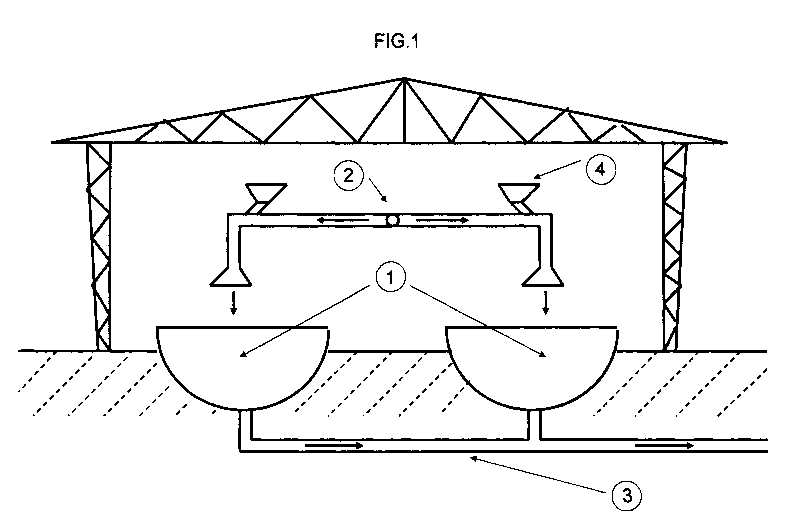Une partie des informations de ce site Web a été fournie par des sources externes. Le gouvernement du Canada n'assume aucune responsabilité concernant la précision, l'actualité ou la fiabilité des informations fournies par les sources externes. Les utilisateurs qui désirent employer cette information devraient consulter directement la source des informations. Le contenu fourni par les sources externes n'est pas assujetti aux exigences sur les langues officielles, la protection des renseignements personnels et l'accessibilité.
L'apparition de différences dans le texte et l'image des Revendications et de l'Abrégé dépend du moment auquel le document est publié. Les textes des Revendications et de l'Abrégé sont affichés :
| (12) Demande de brevet: | (11) CA 2750569 |
|---|---|
| (54) Titre français: | PISCICULTURE MARINE PERMETTANT D'ENGRAISSER DES POISSONS DANS DES PISCINES OU DANS DES BASSINS EN TERRE DANS UNE ATMOSPHERE ASEPTISEE ET CONTROLEE |
| (54) Titre anglais: | MARINE FISH FARMING FOR FATTENING FISH IN PONDS OR POOLS ON LAND IN AN ASEPTIC AND CONTROLLED ENVIRONMENT |
| Statut: | Réputée abandonnée et au-delà du délai pour le rétablissement - en attente de la réponse à l’avis de communication rejetée |
| (51) Classification internationale des brevets (CIB): |
|
|---|---|
| (72) Inventeurs : |
|
| (73) Titulaires : |
|
| (71) Demandeurs : |
|
| (74) Agent: | GOWLING WLG (CANADA) LLP |
| (74) Co-agent: | |
| (45) Délivré: | |
| (86) Date de dépôt PCT: | 2010-01-21 |
| (87) Mise à la disponibilité du public: | 2010-07-29 |
| Licence disponible: | S.O. |
| Cédé au domaine public: | S.O. |
| (25) Langue des documents déposés: | Anglais |
| Traité de coopération en matière de brevets (PCT): | Oui |
|---|---|
| (86) Numéro de la demande PCT: | PCT/CL2010/000003 |
| (87) Numéro de publication internationale PCT: | WO 2010083621 |
| (85) Entrée nationale: | 2011-07-22 |
| (30) Données de priorité de la demande: | ||||||
|---|---|---|---|---|---|---|
|
La présente invention concerne une installation de pisciculture marine en terre. L'installation est constituée de piscines situées ou encastrées dans la terre dans un entrepôt ou une usine. L'installation comprend également des citernes d'eau, des doseurs d'aliments et de la lumière artificielle. Cette installation permet l'engraissement des poissons dans une atmosphère contrôlée et permettant d'éviter toute contamination.
Installation for marine fish farming on land. The installation is made up of
ponds situated
or built into the ground inside a shed or a plant. The installation also
includes water pumps, food
dispensers and artificial light. Fish are fattened in the installation in a
controlled environment,
avoiding contamination.
Note : Les revendications sont présentées dans la langue officielle dans laquelle elles ont été soumises.
Note : Les descriptions sont présentées dans la langue officielle dans laquelle elles ont été soumises.

2024-08-01 : Dans le cadre de la transition vers les Brevets de nouvelle génération (BNG), la base de données sur les brevets canadiens (BDBC) contient désormais un Historique d'événement plus détaillé, qui reproduit le Journal des événements de notre nouvelle solution interne.
Veuillez noter que les événements débutant par « Inactive : » se réfèrent à des événements qui ne sont plus utilisés dans notre nouvelle solution interne.
Pour une meilleure compréhension de l'état de la demande ou brevet qui figure sur cette page, la rubrique Mise en garde , et les descriptions de Brevet , Historique d'événement , Taxes périodiques et Historique des paiements devraient être consultées.
| Description | Date |
|---|---|
| Inactive : CIB désactivée | 2020-02-15 |
| Inactive : CIB en 1re position | 2019-01-17 |
| Inactive : CIB attribuée | 2019-01-17 |
| Inactive : CIB attribuée | 2019-01-17 |
| Inactive : CIB attribuée | 2019-01-17 |
| Inactive : CIB attribuée | 2019-01-17 |
| Inactive : CIB expirée | 2017-01-01 |
| Demande non rétablie avant l'échéance | 2016-01-21 |
| Le délai pour l'annulation est expiré | 2016-01-21 |
| Inactive : Abandon.-RE+surtaxe impayées-Corr envoyée | 2015-01-21 |
| Réputée abandonnée - omission de répondre à un avis sur les taxes pour le maintien en état | 2015-01-21 |
| Inactive : Page couverture publiée | 2011-09-20 |
| Inactive : Notice - Entrée phase nat. - Pas de RE | 2011-09-09 |
| Demande reçue - PCT | 2011-09-09 |
| Inactive : CIB attribuée | 2011-09-09 |
| Inactive : CIB attribuée | 2011-09-09 |
| Inactive : CIB en 1re position | 2011-09-09 |
| Inactive : CIB attribuée | 2011-09-09 |
| Exigences pour l'entrée dans la phase nationale - jugée conforme | 2011-07-22 |
| Demande publiée (accessible au public) | 2010-07-29 |
| Date d'abandonnement | Raison | Date de rétablissement |
|---|---|---|
| 2015-01-21 |
Le dernier paiement a été reçu le 2014-01-09
Avis : Si le paiement en totalité n'a pas été reçu au plus tard à la date indiquée, une taxe supplémentaire peut être imposée, soit une des taxes suivantes :
Veuillez vous référer à la page web des taxes sur les brevets de l'OPIC pour voir tous les montants actuels des taxes.
| Type de taxes | Anniversaire | Échéance | Date payée |
|---|---|---|---|
| Taxe nationale de base - générale | 2011-07-22 | ||
| TM (demande, 2e anniv.) - générale | 02 | 2012-01-23 | 2012-01-16 |
| TM (demande, 3e anniv.) - générale | 03 | 2013-01-21 | 2013-01-18 |
| TM (demande, 4e anniv.) - générale | 04 | 2014-01-21 | 2014-01-09 |
Les titulaires actuels et antérieures au dossier sont affichés en ordre alphabétique.
| Titulaires actuels au dossier |
|---|
| ASESORIAS E INVERSIONES MARINE TECH S.A. |
| Titulaires antérieures au dossier |
|---|
| MAX RICARDO STRUBE OTEGUI |